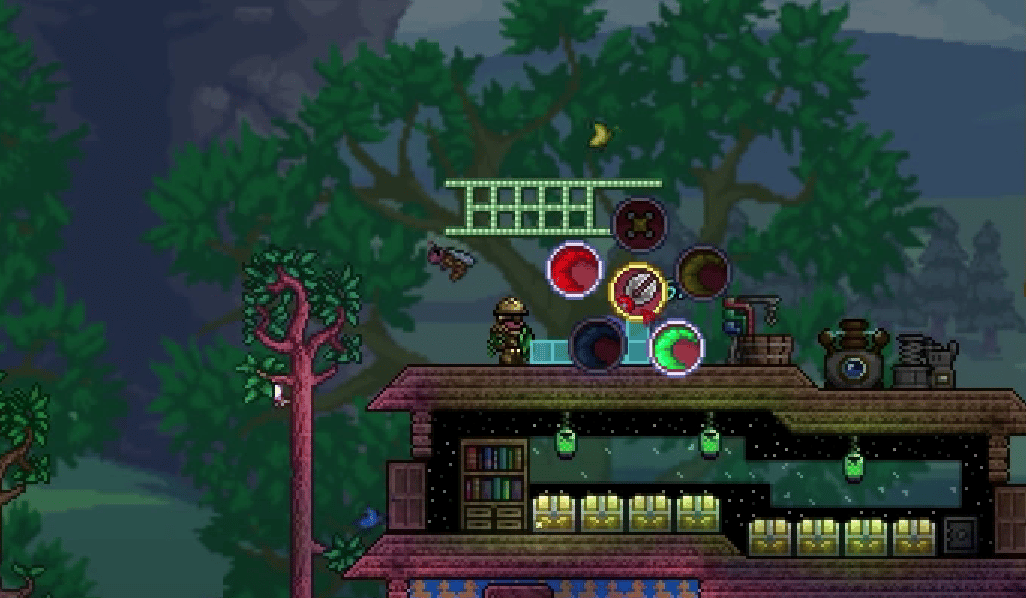The Corruption is one of three evil biomes in the game, alongside Crimson and Hallow. Each one of them has a tendency to slowly overtake your world, preventing you from accessing other materials. In the end, you might lose progress and will resort to creating a new file.
As the environment changes, so do the monsters. The newly converted biome will bring tougher enemies such as Eater of Souls, Devourer, and many more. Having one and the same opponents also limits the loot you can acquire in the game.
What are Corruption and Crimson?
Corruption and Crimson are two evil biomes in the game. We also have Hallow, a Hardmode exclusive biome that spreads in a similar way as these two but doesn’t cause the same issues.
Whenever you create a new world, there’s a 50% chance that one of these two evil biomes will appear. Mostly, they’re interchangeable and works similarly except from monsters, loot, and bosses.
It’s easy to tell if a world is turned into Corruption or Crimson based on color schemes. The Crimson biome features a blood red color, while the Corruption environment has musky purple. Each one of them has a unique music theme playing as you traverse the area.
Aside from the music and colors, there are other things that indicates an evil biome. Corruption features purple mountains, grass, and numerous dead trees. The background effects are also gloomier compared to healthy regions. This is the only place where you can find Chasms, Shadow Orbs, Ebonstone, Demon Altars, and Vile Mushrooms.
The bosses in these two areas are also different. Brain of Cthulhu is common for red worlds and Eater of Worlds for purple ones.
What Corruption Does to Your World
As time passes, this biome will start spreading its influence. The surrounding areas will turn purple, trees and grass will change, and the infected area will be inhabited by different monsters. Here are the main reasons why you should stop this spread:
- This evil environment can destroy other areas, thus preventing game completion.
- It’ll remove other monsters and bosses from the game, making it impossible to get certain loot.
- The monsters that spawn in this environment are much tougher, making the game tougher overall. It’s best to avoid them at the start of the game.
- NPCs won’t spawn in Corruption and Crimson regions. If it affects your base, it’ll prevent the spawning of Steampunker, a vendor who sells a tool for removing infected tiles.
Aside from all these things, the spread also affects playability. You don’t want to fight the same opponents over and over again. The game quickly becomes dull and frustrating.
How does the Corruption Spread?
Here are some rules regarding Corruption spread:
- Corruption blocks can covert almost any block as long as they’re within three to six tiles.
- During pre-Hardmode, the infection can only affect bushes and grass. So, creating a stone wall on both sides of the biome is a good solution that would temporarily stop the spread.
- Once you reach Hardmode, the spread will also occur underground and can go through stone and vines. It becomes more menacing, turning any tile into its Corruption counterpart.
- The infection normally spreads during pre-Hardmode. Once you kill Wall of Flesh, it starts spreading at double speed and turns back to normal after defeating Plantera. When the game goes into Harmode, you should rush this boss as soon as possible.
- Keep in mind that the infection spreads six times faster on the surface, so this should be your priority when removing the infected blocks.
- The best way to determine the spread speed is by checking the surface. The infection will first start affecting grass, turning it from green to purple color. This will also spawn thorns, which can cause damage as you run through them, making traveling annoying.
- Like the biome, thorns take over surrounding areas, spawning in larger quantities as long as they’re four tiles from health blocks.
- Be careful when destroying Demon Altars. Their destruction is necessary for spawning new Hardmode ores. However, crushing one of them will also turn random blocks on the map into their Corruption counterpart. That way, the infection can spread to areas you previously insulated.
- When certain biomes become infected, this will lead to the creation of new, unique monsters. For example, the Corrupted Desert will allow the spawning of Dark Mummies.
How to get rid of corruption in Terraria?
The best way to tackle the issue is by introducing preventative measures during pre-Hardmode. Given that the spread is negligible during this phase, you can take your time and create massive structures, thus getting ready for Hardmode.
Protecting the base
The first thing you have to do is to suspend your base in the air. This will prevent infection from spreading to your houses. In other words, you can rest assured that the NPCs will always spawn within the base. This is crucial when you unlock Steampunker and Clentaminator.
Keep in mind this will cause a few issues until you can create a Bed. You’ll always spawn on the ground, beneath the base, and you’ll have to climb up to reach crafting stations.
Alternatively, you can dig a massive moat around the base that spreads horizontally and vertically. This will insulate the ground just beneath the structure. You can leave it empty, or you can fill it with non-corruptible materials.
Ideally, the moat should be six tiles wide on all sides, thus preventing the spread from the outside. Keep in mind that Corruption Blocks might still appear beneath your base when you destroy Demon Altars.
You might also consider placing Hallow Blocks around your base, encircling them with Mud Blocks from the inside. Hallow will stop the spread of Crimson and Corruption from the outside, and Mud Blocks prevent the spread of Hallow toward the inside. Unfortunately, this also means that Hallow enemies will start appearing close to your base.
Hellavator and segmentation
Hellavator is a hole that leads straight to lava level. It’s an efficient way to traverse the underground, and it definitely speeds up your mining time.
Hellavators have another purpose, and that’s the segmentation of the map. You can use them to isolate the base along vertical lines, as well as biomes of interest (Jungle, in particular). That way, you can rest assured that the Corruption won’t spread from the sides, especially on the surface.
Alternatively, you can make two Hellavators on both sides of the evil biome. By doing so, you contain the whole zone.
After creating a few Hellevators, you might also want to consider creating horizontal shafts that spread throughout the map. You can even install Minecarts for fast travel between sections. By doing these things, you’ll split up the map into sections. If Corruption starts converting a part of the map, you can go there and remove troublesome blocks.
These steps are especially effective if you don’t destroy too many Demon Altars.
Clentaminator
Clentaminator is a tool that you can buy from Steampunker after defeating mechanical bosses. It allows you to shoot different types of solutions, turning nearby blocks into appropriate biomes. For example, you can use it to turn regular blocks into Hallow, Crimson, and Corruption counterparts, but also to revert them back to normal.
Clentaminator is great for the surface, but it tends to struggle while underground. As you’re moving through the shafts, you can’t spray all of the infected tiles within the ground. One of the best ways to improve its efficiency below the surface level is by creating Hellavators and spraying both sides of the walls as you go downward.
To make the most out of the tool, it’s recommended that you perform map segmentation, as explained in the previous section. Keep in mind that these solutions are extremely expensive. One unit costs 25 silver, and to buy a stack of 999 Green Solutions, you need more than 25 platinum coins.
Out of the five available solutions, you need to focus on Green Solution that allows you to purify blocks are restore them to the previous biome. The material works like ammo by placing it in ammunition inventory.







